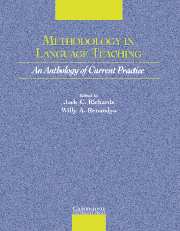Book contents
- Frontmatter
- Contents
- Acknowledgments
- Introduction
- Section I Approaches to Teaching
- Section 2 Lesson Planning and Classroom Management
- Section 3 Classroom Dynamics
- Section 4 Syllabus Design and Instructional Materials
- Section 5 Task and Project Work
- Section 6 Learning Strategies
- Section 7 Teaching Grammar
- Section 8 Teaching Pronunciation
- Section 9 Teaching Speaking
- Section 10 Teaching Listening
- Section 11 Teaching Vocabulary
- Section 12 Teaching Reading
- Section 13 Teaching Writing
- Section 14 Assessment
- Chapter 33 Alternative Assessment: Responses to Commonly Asked Questions
- Chapter 34 Nontraditional Forms of Assessment and Response to Student Writing: A Step Toward Learner Autonomy
- Chapter 35 English Proficiency Test: The Oral Component of a Primary School
- Section 15 Technologies in the Classroom
- Section 16 Professional Development
- Credits
- Author Index
- Subject Index
- References
Chapter 35 - English Proficiency Test: The Oral Component of a Primary School
Published online by Cambridge University Press: 10 November 2010
- Frontmatter
- Contents
- Acknowledgments
- Introduction
- Section I Approaches to Teaching
- Section 2 Lesson Planning and Classroom Management
- Section 3 Classroom Dynamics
- Section 4 Syllabus Design and Instructional Materials
- Section 5 Task and Project Work
- Section 6 Learning Strategies
- Section 7 Teaching Grammar
- Section 8 Teaching Pronunciation
- Section 9 Teaching Speaking
- Section 10 Teaching Listening
- Section 11 Teaching Vocabulary
- Section 12 Teaching Reading
- Section 13 Teaching Writing
- Section 14 Assessment
- Chapter 33 Alternative Assessment: Responses to Commonly Asked Questions
- Chapter 34 Nontraditional Forms of Assessment and Response to Student Writing: A Step Toward Learner Autonomy
- Chapter 35 English Proficiency Test: The Oral Component of a Primary School
- Section 15 Technologies in the Classroom
- Section 16 Professional Development
- Credits
- Author Index
- Subject Index
- References
Summary
INTRODUCTION
Many teachers feel comfortable setting pencil-and-paper tests. Years of experience marking written work have made them familiar with the level of written competence pupils need in order to succeed in a specific standard. However, teachers often feel much less secure when dealing with tests which measure speaking and listening, even though these skills are regarded as essential components of a diagnostic test which measures overall linguistic proficiency. Although the second language English pupils often come from an oral rather than a written culture, and so are likely to be more proficient in this mode of communication, at least in their own language, speaking in English may be a different matter. In English-medium schools in particular, a low level of English may impede students' acquisition of knowledge. Therefore, identifying the correct level of English of the student is all the more challenging and important.
This article outlines some of the problem areas described by researchers when designing a test of oral production for beginning-level speakers of English and suggests ways in which they may be addressed.
HOW DOES ONE SET A TEST WHICH DOES NOT INTIMIDATE CHILDREN BUT ENCOURAGES THEM TO PROVIDE AN ACCURATE PICTURE OF THEIR ORAL ABILITY?
In replying to this question, one needs to consider briefly the findings of researchers working in the field of language testing.
- Type
- Chapter
- Information
- Methodology in Language TeachingAn Anthology of Current Practice, pp. 354 - 360Publisher: Cambridge University PressPrint publication year: 2002



